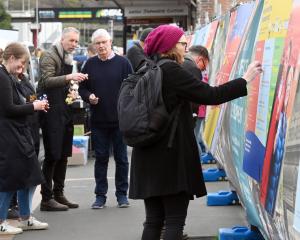Keys in hand, Roberta Coutts opens a series of dark doors to reveal one surprise after another - a recording studio, a climbing room and finally, what looks like a hospital ward.
The film-makers hiring the last room are making a pilot for television, she says, pointing out the three beds they have wheeled in on the vinyl floor.
"They've put in curtain rails. They're just out looking for bedside tables and drip stands."
Every month, she reads 70 electricity meters and cleans 30 heatpump filters.
Every day, she scrubs 26 toilets and walks 6km to 9km along the sweeping corridors that are said to be inhabited by a ghost. She also collects rents and sorts out occasional problems with tenants - all while running her own business from the building, making Montessori resources and shipping them worldwide.
Once home to the biggest high school in the country, the King Edward building with its 30,000sq m of floor space is still a busy central-city landmark.
But reminders of its educational past are few and far between - among them, a prefects' room with tiled fireplace, the seat outside the principal's office where many a worried schoolboy sat and holes that pupils made in the concrete with coins, and an old garage complete with pit.
Popularly called the school for roughs, the institution prepared boys for working lives as plumbers, electricians and mechanics, and girls for jobs as shorthand typists.
But Coutts says the school also had a big emphasis on music and provided an "interesting mix of culture and trade".
"It's something we should be doing now - that kind of school where children needing hands-on practical work can get the first two years of a trade under their belt before leaving school, instead of floundering around at university trying to figure out what it is that they're passionate about."
The building's first private owner, Alex Firestone, ran an English language school and a small international high school. When he put the property up for sale in 2000, there was talk of it being turned into apartments or a hotel but instead it became a hub for community groups, sports clubs and small businesses.
Coutts likes that owners Ray and Gwynn Joseph, now living in the United States, have not tried to turn it into something it isn't but kept it as an institutional building and let ordinary Dunedin folk use it.
While some would see the interior of the $2.1 million property as stark and utilitarian, she describes it as beautiful.
"It's got some gorgeous features," she says from her workspace, originally the school's staff room and teachers' library.
"I love the height of it, the ceilings, the timber."
Almost all of the 75 rooms are occupied, at rents of between $50 and $150 per week. Tenants range from a radio station, a wind turbine company and the Fortune Theatre wardrobe to those offering burlesque classes.
Some are "lifers", she says, explaining how the Bennett School of Ballet and Jazz has added more rooms as needed and now has an entire wing to itself. Others have rented coal bunkers and toilet blocks for storage.
Black Seeds guitarist Mike Fabulous searched the entire premises before settling on a nondescript storage room for a recording studio.
Six bands practise in the building at nights and weekends and eight more are waiting for rooms to become available.
Coutts says there is the odd argument, "as in any family", but she sorts them out eventually.
"They call me Mum, some of them. It's a big building. There's a lot of people. And I'm kind of the constant, the one who's always here that they can talk to."
On a practical level, the biggest issue is a lack of parking, she says. The owner has fixed leaks in the roof, and attended to plumbing and electrical work, but the infrastructure is old and sometimes "gives way".
Peter Green, who occupies one of two flats in the property, says it is the opposite of apartment blocks which are empty during the day and busy after work. The vast building is quiet at night and with its dim lighting, could easily double for the set of a horror movie.
"It just goes on and on. I haven't seen all the little corners."
Coutts has not mentioned the ghost, said to be the spirit of a 13-year-old girl who fell to her death on a stairwell, but Green seems untroubled.
His flat - with its high ceiling and slightly patched-together look - provides easy access to town and a bouldering room to train in, just downstairs.
A party will mark the building's centennial in 2013 but in the meantime, Coutts hopes former pupils will be happy that it is still used by hundreds of people each week.
"She's a grand old lady. I love her."
Largest in NZ for 20 years
King Edward Technical College was New Zealand's largest secondary school for more than 20 years.
The Dunedin Technical Classes Association was founded in 1888 and proved so successful that finding suitable accommodation was an ongoing problem. Finally, in 1914, the purpose-built King Edward Technical College was opened in Stuart St.
The three-storey brick property was designed by prominent architect Harry Mandeno.
The building was completed with the addition of a swimming pool and assembly hall, Burt Hall, in 1918, and the Thomson wing was added in 1923.
The Dunedin Art School was part of the college from 1921 but did not get its own building on the corner of York Pl and Tennyson St until 1937, when the pupils included a 17-year-old Colin McCahon.
By 1955, the school had more than 1300 day pupils, making it the largest school in New Zealand, and the total roll was 2500.
In the 1960s, the college was divided into two independent sections - Otago Polytechnic and King Edward High School - as a first step towards moving technical education from the secondary to the tertiary system.
The high school moved to new facilities in north Dunedin (Logan Park High School) in 1974 and most of the polytechnic moved to its Forth St campus in 1989.
More than 630 people have registered for next weekend's school reunion, whichwill celebrate 100 years of day-school education, 120 years of night school and 140 years of art school.












